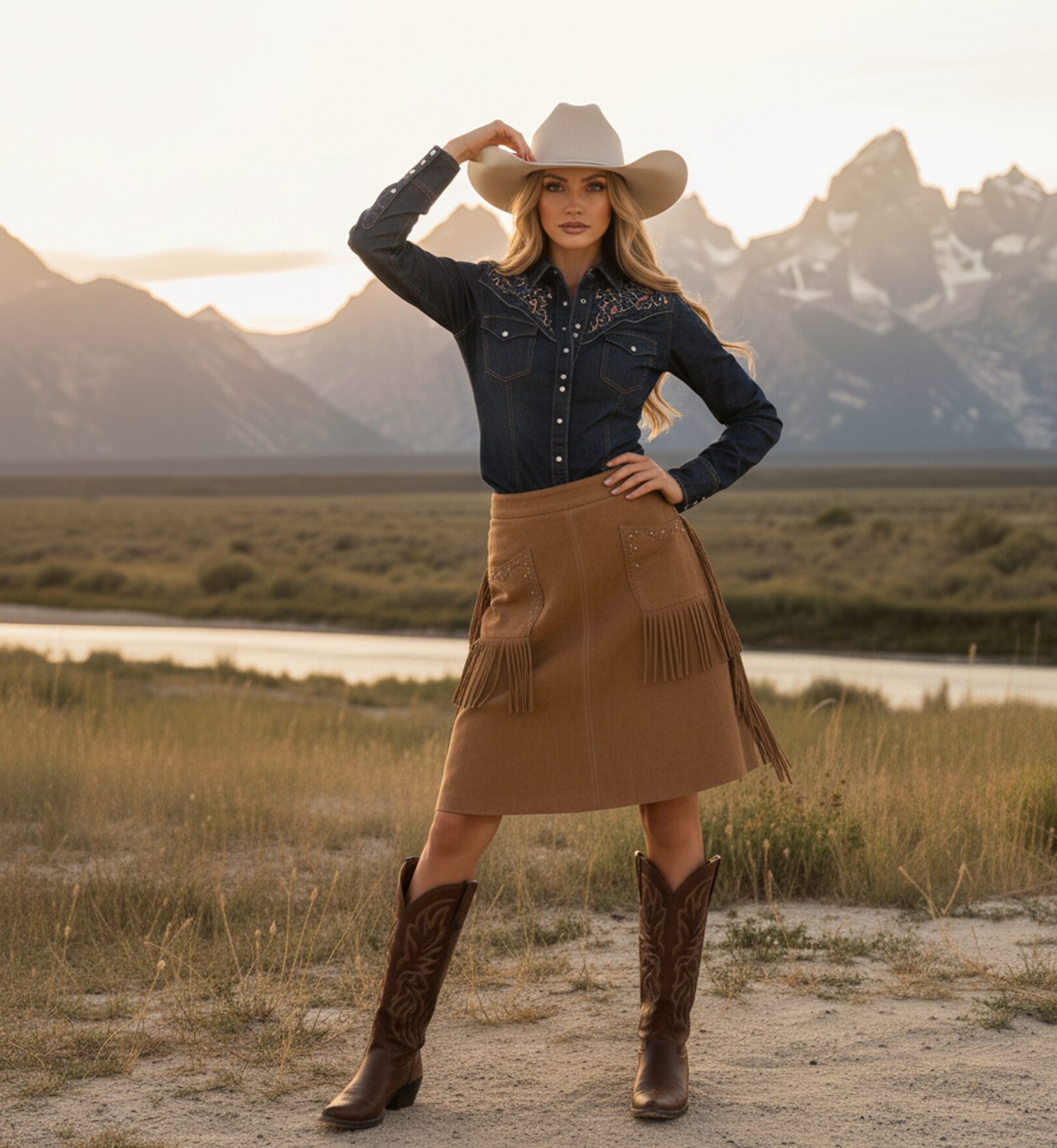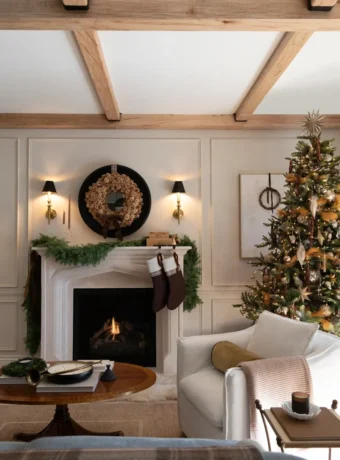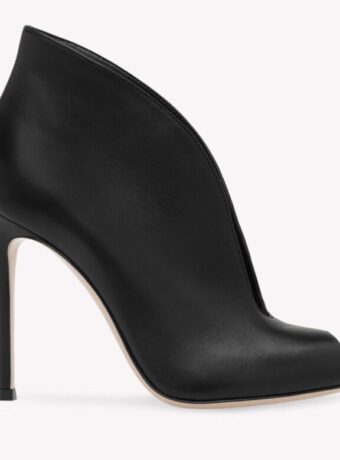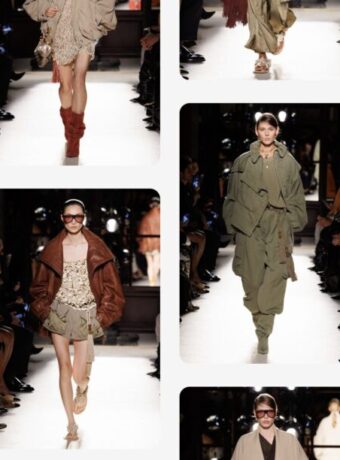The Western Boot Industry: A Deep-Dive from Ranch to Runway
*Disclosure: This post may contain affiliate links. If you make a purchase, we may earn a small commission at no extra cost to you. Thanks for supporting TwoStep and Tequila!
Cowboy boots are one of the rare style categories where heritage, function, and fashion collide. They aren’t just footwear—they’re identity markers, cultural exports, and billion-dollar businesses. From Lucchese’s hand-pegged exotics in Texas, to Ariat’s tech-infused workhorses, to Paris Texas’ crocodile-embossed luxury boots on the Milan runways, Western boots today sit at the intersection of tradition and transformation.
This is your ultimate guide to understanding the industry—who matters, why they matter, and where the future is headed.
- Calf Leather Shaft
- Full quill ostrich leather vamp
- Traditional embroidered design on shaft
Heritage Icons: The Bedrock of Western Boots
-
Lucchese (est. 1883) – Handmade in Texas, Lucchese represents the pinnacle of Western luxury. Their boots are still hand-lasted and pegged with lemonwood, often using exotic skins. At $600–$5,000+, they are less a utility boot and more an heirloom piece—favored by presidents, celebrities, and serious collectors.
-
Justin & Tony Lama (est. 1879 & 1911) – Justin is the blue-collar workhorse; Tony Lama the style innovator. Together, they dominate the mid-market through scale and distribution, delivering boots that balance durability and style. Owned by Berkshire Hathaway, they remain volume leaders in ranch, rodeo, and casual Western wear.
-
Tecovas (est. 2015) – The disruptor. A DTC-first brand, Tecovas built a cult following with “radical hospitality,” approachable premium pricing ($275–$650), and stylish Austin-inspired designs. They’ve proven there’s appetite for modern heritage—boots that feel authentic but also frictionless to buy.
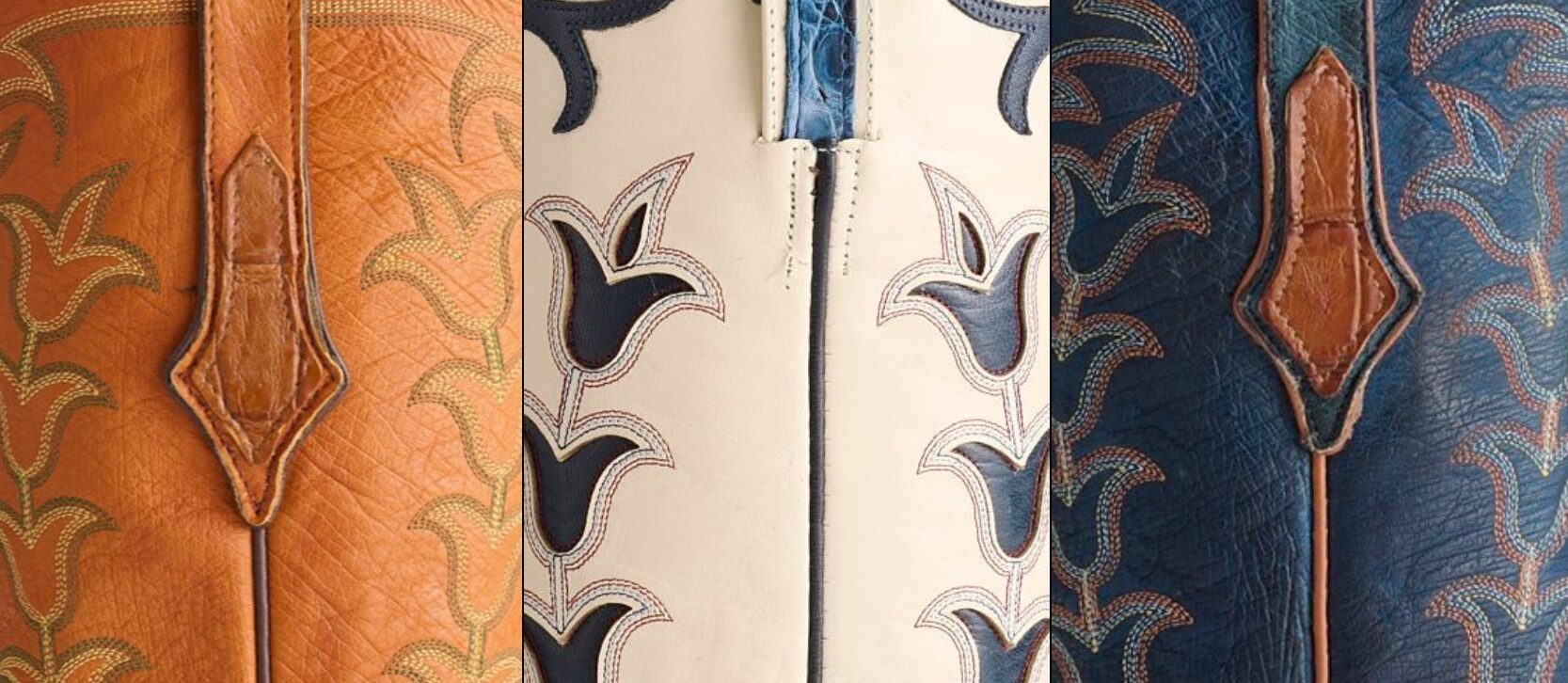
The Overlooked Share Leaders
Several brands don’t get the same cultural spotlight but hold significant market presence:
-
Dan Post (1965) – Known for “handcrafted cushion comfort”, Dan Post pioneered the idea that cowboy boots could feel broken-in from day one. With sub-brands Laredo (value) and Dingo (fashion), they cover entry-level to mid-market. Price: $180–$400.
-
Ariat (1993) – The most important addition to the conversation. Ariat merged athletic shoe technology with Western style, creating a global equestrian and Western powerhouse. With ATS footbeds, rubber outsoles, and even premium bench-made lines, Ariat has become the largest Western boot brand in the world. Price: $150–$300+.
-
Anderson Bean & Rios of Mercedes (1980s & 1853) – Handmade in Texas, these brands preserve true cowboy bootmaking. Anderson Bean sits in the $300–$600 tier for working cowboys, while Rios delivers bespoke-level artistry ($600–$1,000+). Sub-brands like Horse Power and Macie Bean allow them to ladder consumers from entry to fashion.
-
Double-H (1955) – The fusion of work and Western. Famous for the first steel-toe cowboy boot and its I.C.E.™ outsoles, Double-H serves farmers, construction crews, and rodeo hands who need ruggedness and safety without losing Western style. Price: $180–$320.
-
Corral (1999) – Handmade in León, Mexico, Corral “revolutionized cowgirl boots.” Known for embroidery, studs, and glittering finishes, they dominate the women’s fashion Western market. Price: $200–$500.
-
Durango (1966) – Entry-level and youth-friendly. Lightweight, bold designs (like American flag shafts) make them a volume brand for first-time buyers. Price: $120–$190.
-
Twisted X (2005) – A modern comfort and sustainability brand. With eco-friendly materials and casual Western silhouettes, they attract consumers who value comfort as much as tradition. Price: $140–$240.
When Luxury LARPs as Western
Fashion houses have turned cowboy boots into runway icons. While they don’t hold share like Ariat or Justin, their influence on global perception is massive.
-
Paris Texas (Italy, 2015) – Chic, pointed-toe cowboy silhouettes made in Italy. At $700–$1,000, they’re staples for influencers and celebrities.
-
Christian Louboutin (France) – The “Giddy Up” capsule turned cowboy boots into couture, with crystals, embroidery, and price tags north of $2,000.
-
RRL by Ralph Lauren, Isabel Marant, Gucci, Dior, Celine – All have put cowboy boots on the runway, validating cowboy boots as fashion’s perennial muse.
These luxury entrants don’t compete on function—they compete on image. Their presence keeps cowboy boots in fashion headlines, helping mainstream adoption.
- Material:This poncho shawl is made of viscose &polyester. woven, soft cashmere-like.
- Size:Measurement of the poncho wrap: length - 31.5"/80cm. width - 45"/114cm.
- Feature:Classic check, double sided, tab at the front, one size fit most.
- Occasion: Our shawl wrap poncho is a great ideal for evening dresses or wedding party, and great as a warm scarf during cold winter. These shawl are perfect for matching any outfits in the daily life, travel, evening party, wedding, prom party or any other festivals.
- Gift: A year-round on trend style, layer it over a light long sleeve shirt for extra warmth,You can dress it up or down with a pair of jeans and boots or go with a long dress. It's easy to wear and go with everything.This would make a beautiful gift for Mothers Day and daily gift for ladies wife, mother, grandma, mother in law.
The International Stampede
Western boots are now global, both in demand and production:
-
Cuadra (Mexico) – Exotic leather artisans (caiman, ostrich, python) with ornate detailing. Cuadra is Mexico’s luxury boot export, expanding in the U.S. and Europe. Price: $300–$800+.
-
Sendra (Spain) – Over 100 years of Goodyear-welted craft. A pillar of Europe’s cowboy boot market, balancing authenticity with Mediterranean design. Price: €250–€400.
-
Boulet (Canada) – Canada’s first Western boot brand, family-owned since 1933. Known for fit, durability, and supplying the RCMP. Price: $250–$400.
Where the Industry is Headed
The future of Western boots rests on three intersecting forces:
-
Heritage vs. Hospitality – Brands like Lucchese and Rios will always command respect for artisanal craft, but Tecovas and Ariat prove the future requires frictionless experiences and clear storytelling.
-
Women’s Fashion as a Growth Engine – Corral, Durango, and Paris Texas show that cowgirl boots are no longer niche—they’re center stage in festivals, weddings, and runways.
-
Globalization – Sendra in Europe, Cuadra in Mexico, Boulet in Canada, and Ariat’s worldwide reach prove cowboy boots are now global fashion and lifestyle products.
From the ranch to the runway, cowboy boots are no longer just American—they’re universal. And that universality is what makes them so powerful in fashion and culture.
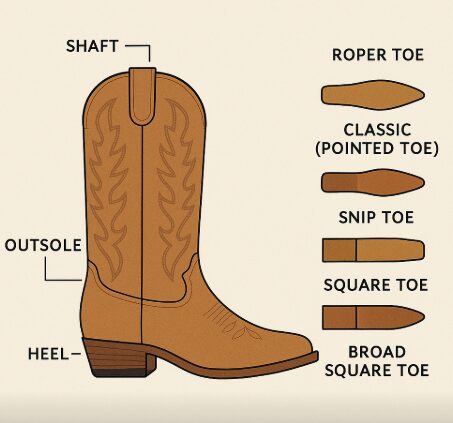
The Anatomy of a Cowboy Boot
Understanding boots starts with knowing the parts. Every piece has a purpose:
-
Shaft – The tall upper part of the boot that covers the leg. Heights vary from 8” roper styles to 14”+ traditional cowboy shafts.
-
Vamp – The front/top part of the boot that covers your foot; often made of the most decorative or exotic leather.
-
Heel – Cowboy boots traditionally have underslung heels, ranging from low “roper” heels (easy walking) to higher “riding” heels (for stirrup control).
-
Outsole – Usually leather or rubber; leather for tradition, rubber for grip.
-
Insole & Shank – Interior structure for comfort and support. Higher-end boots often use lemonwood pegs or Goodyear welts.
-
Pull Straps/Pull Holes – Loops at the top to help you pull the boots on.
Common Toe Shapes
The toe shape defines both the look and function of the boot.
-
Roper Toe (Round Toe) – Rounded, roomy, great for everyday wear.
-
Classic (Pointed Toe) – Traditional cowboy look, narrower profile.
-
Snip Toe – Sharp squared-off point; fashion-forward, popular for women’s boots.
-
Square Toe – Wider, flat front; huge in modern Ariat and work boots.
-
Broad/“Wide” Square Toe – Extra roomy; especially popular for rodeo and ranch work.
Heel Styles
Cowboy boot heels are as distinctive as the toes:
-
Roper Heel – Short, squared-off, comfortable for all-day wear.
-
Walking Heel – Slightly higher than roper, with a subtle slant.
-
Riding Heel – Tall, underslung heel designed for stirrups.
-
Fashion Heel – Taller, slimmer, often found on women’s boots and luxury designs.
Leathers & Materials
-
Cowhide – Durable, affordable, the most common choice.
-
Ostrich – Soft, supple, instantly recognizable by its quill marks.
-
Lizard, Alligator, Caiman, Python – Exotic leathers prized for texture and luxury.
-
Goat – Flexible, resilient, with a matte finish.
-
Kangaroo – Surprisingly lightweight and strong.
How to Choose
-
For Work: Look for roper or wide square toe, roper heel, and durable cowhide.
-
For Dress: Snip or classic pointed toe, taller heel, exotics like ostrich or lizard.
-
For Fashion: Bold leathers, embroidery, crystals, or luxury labels (Paris Texas, Louboutin).
-
For Collectors: Handmade heritage boots (Lucchese Classics, Rios of Mercedes).
